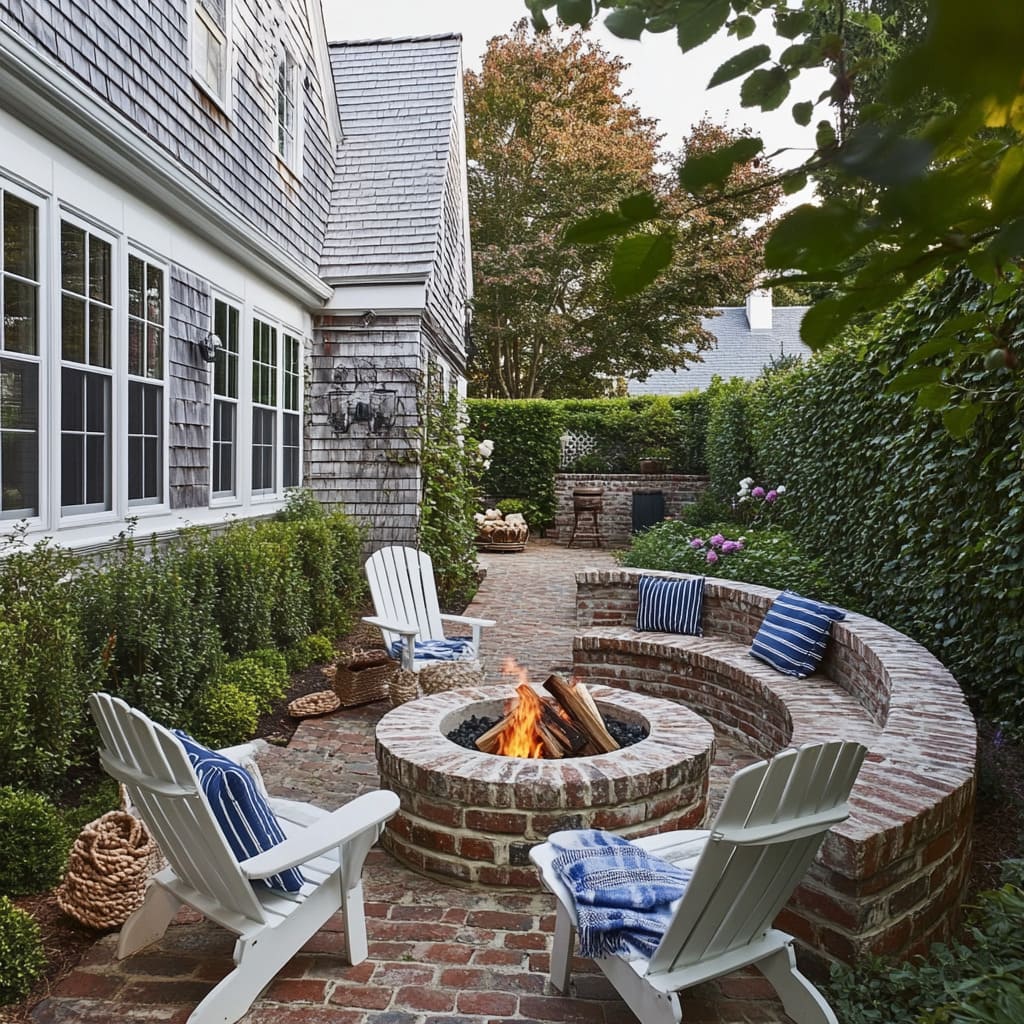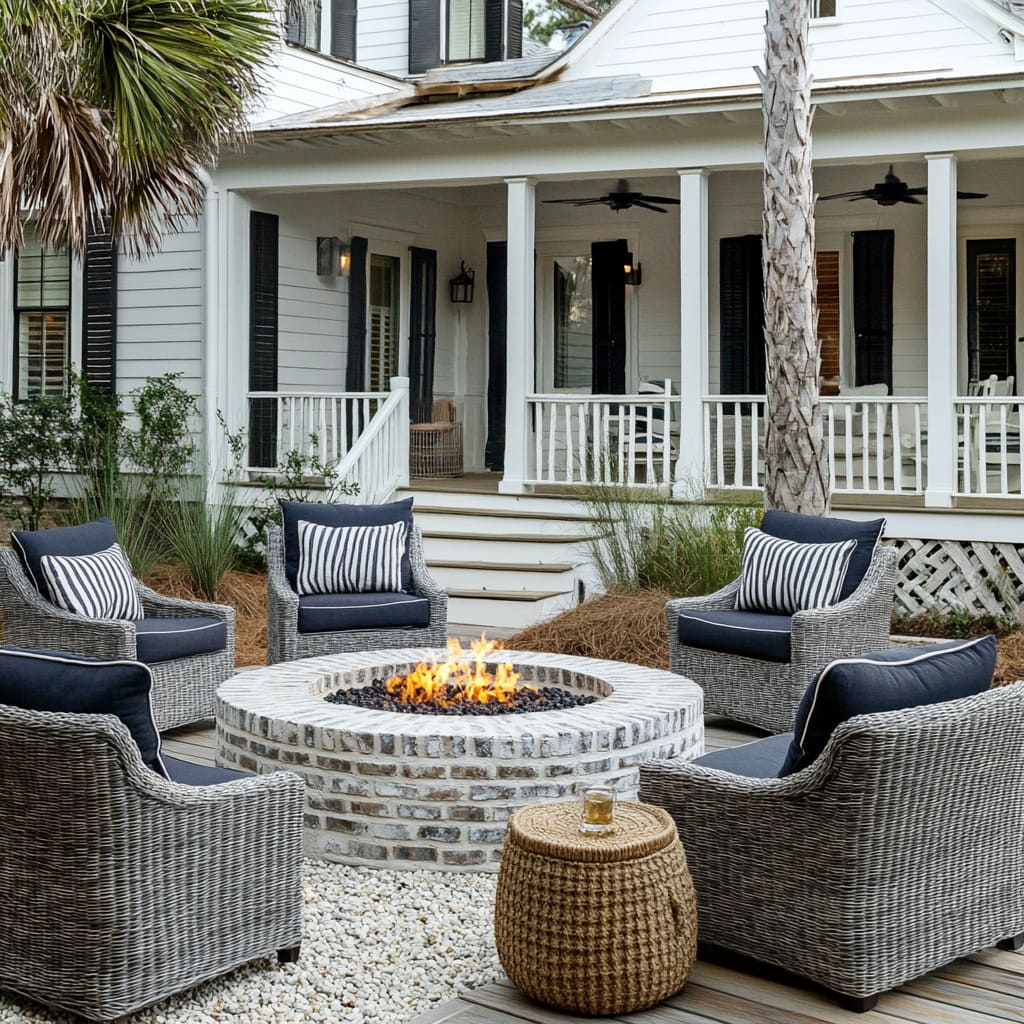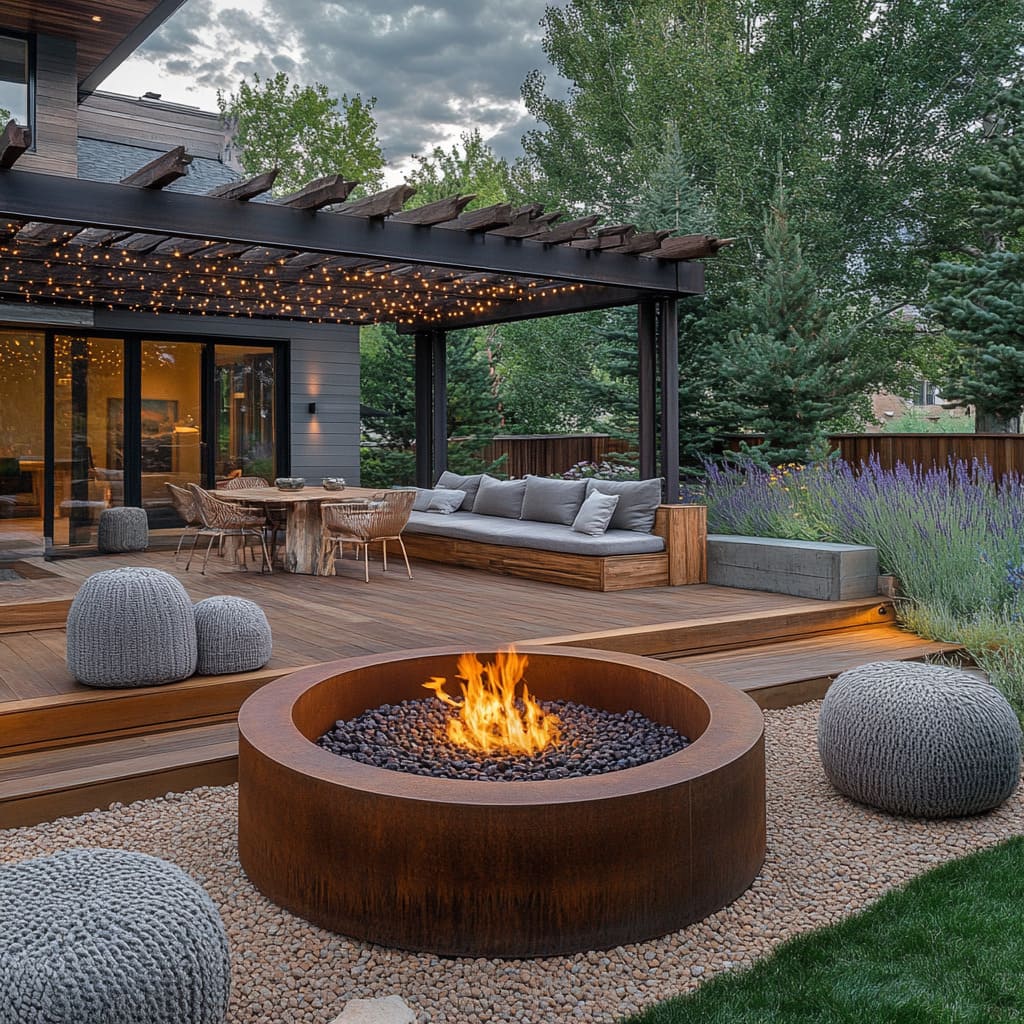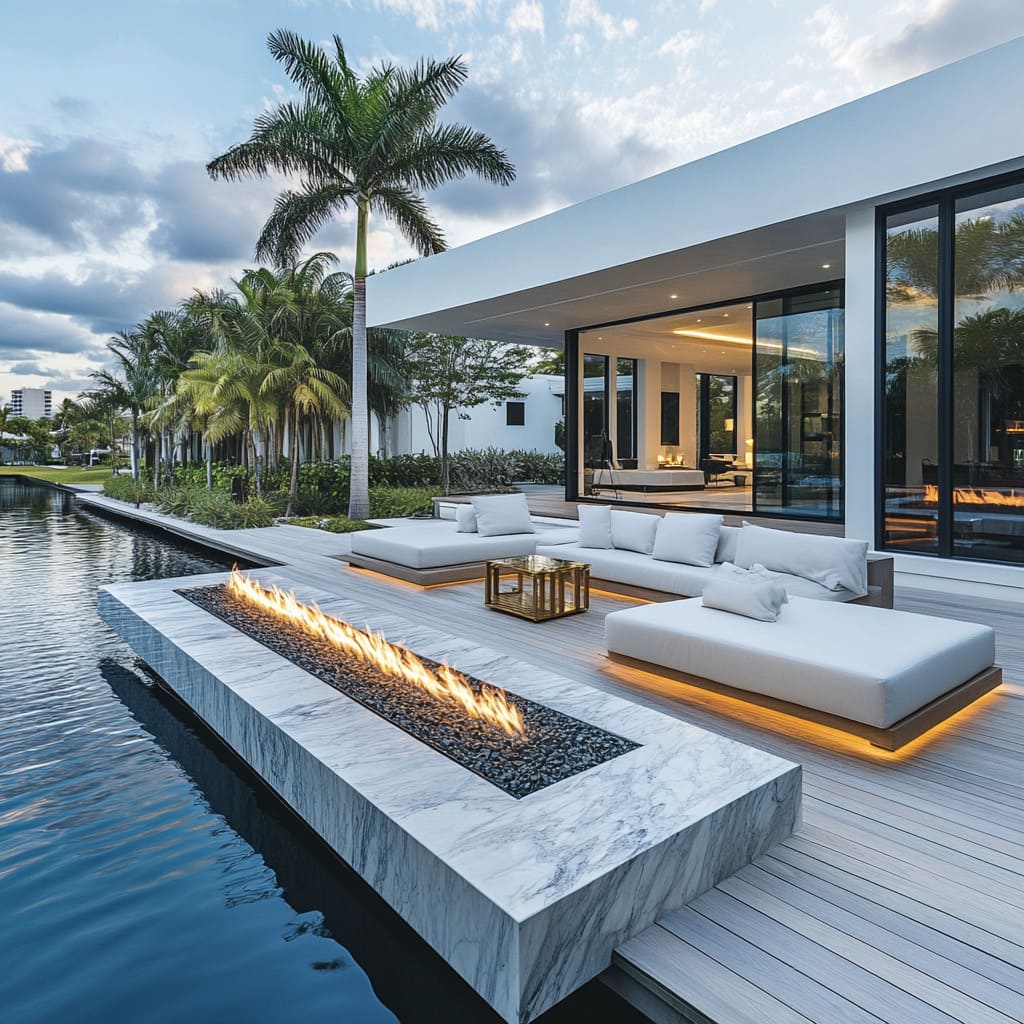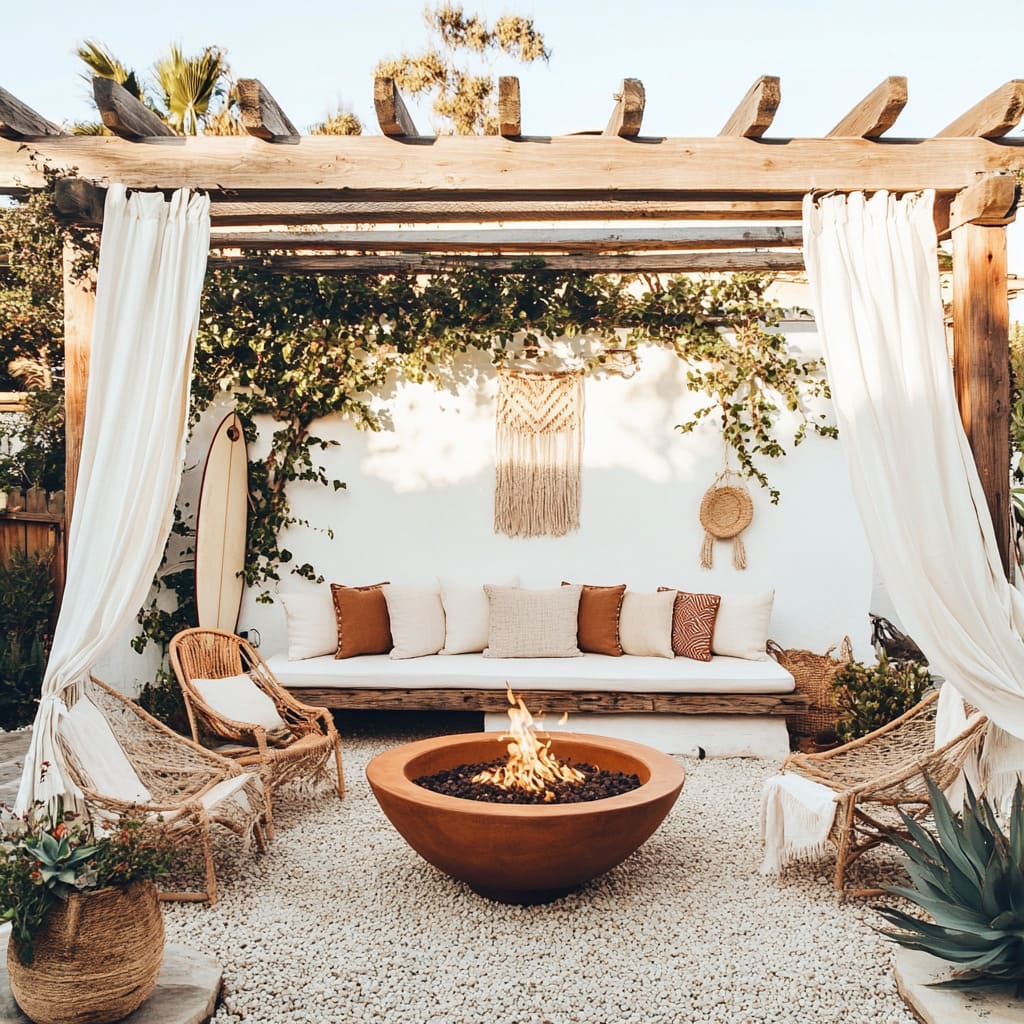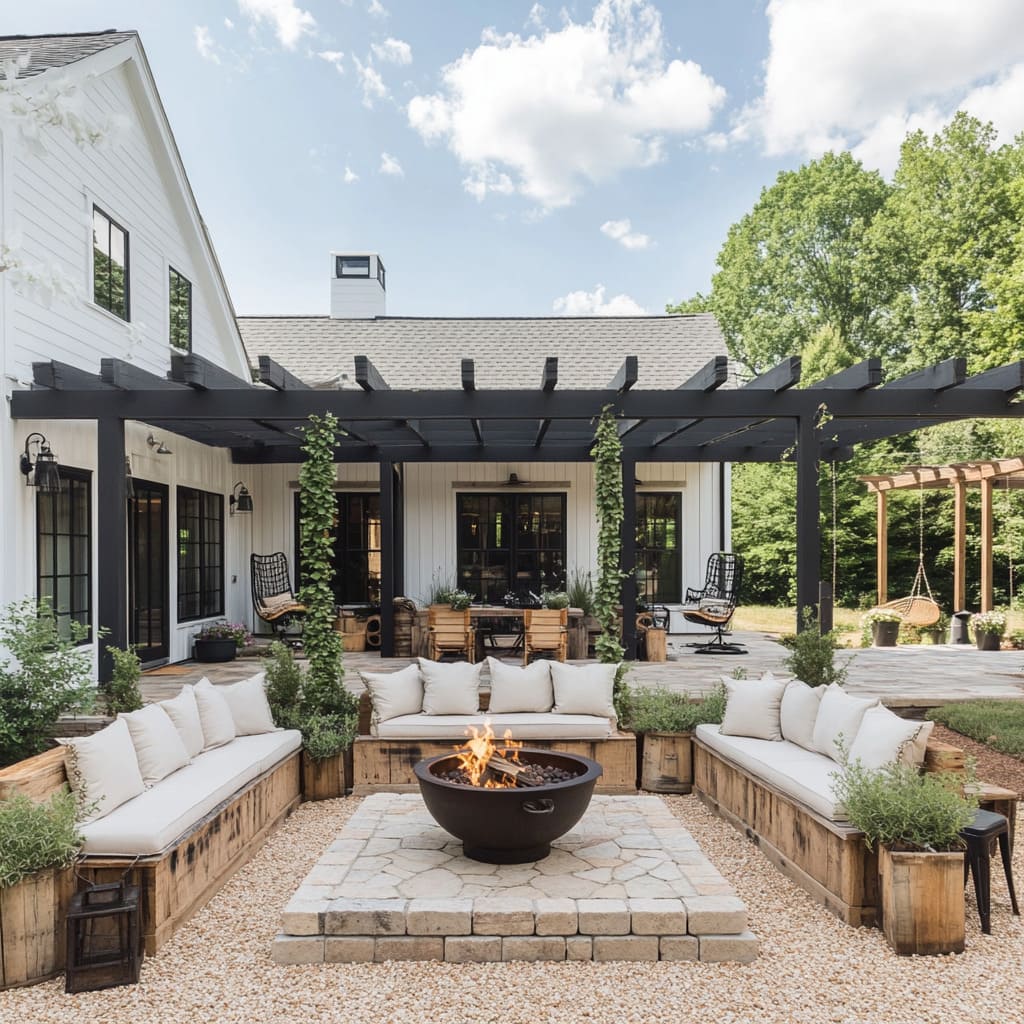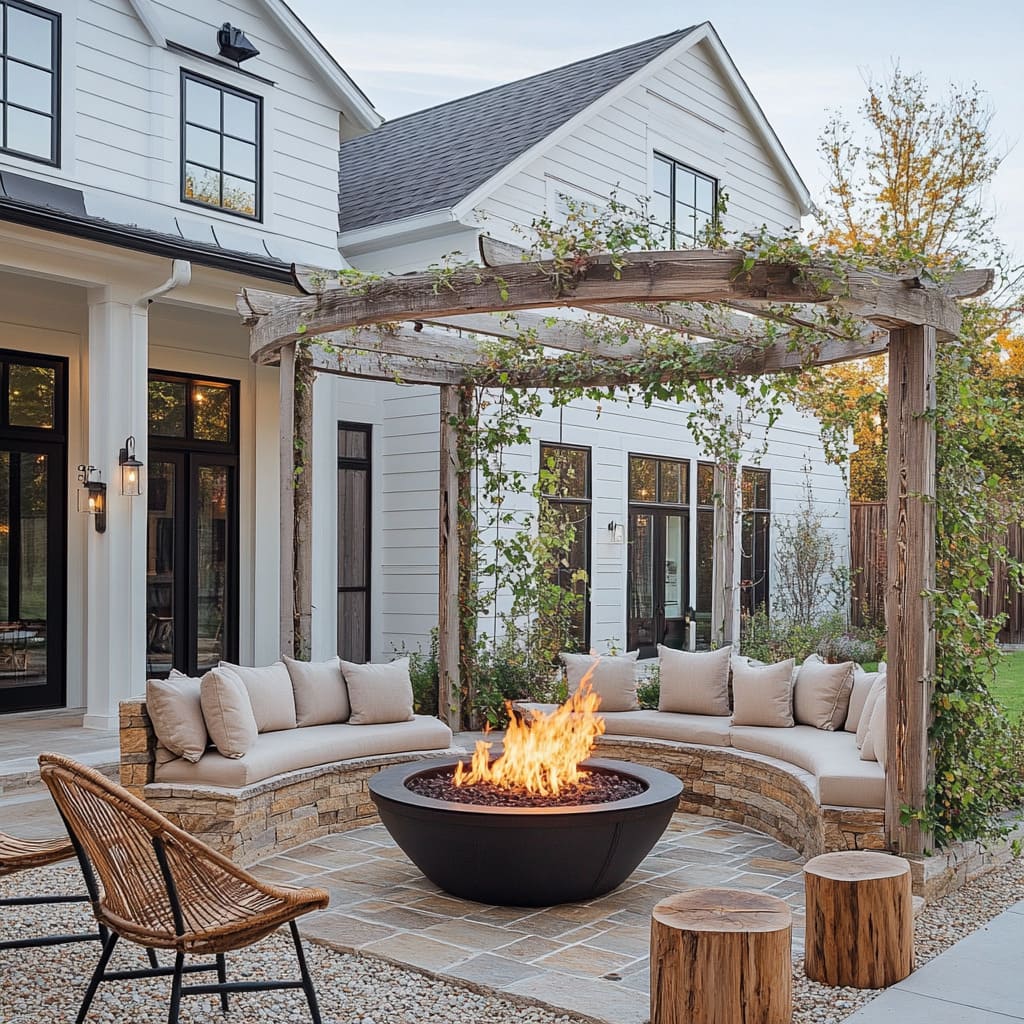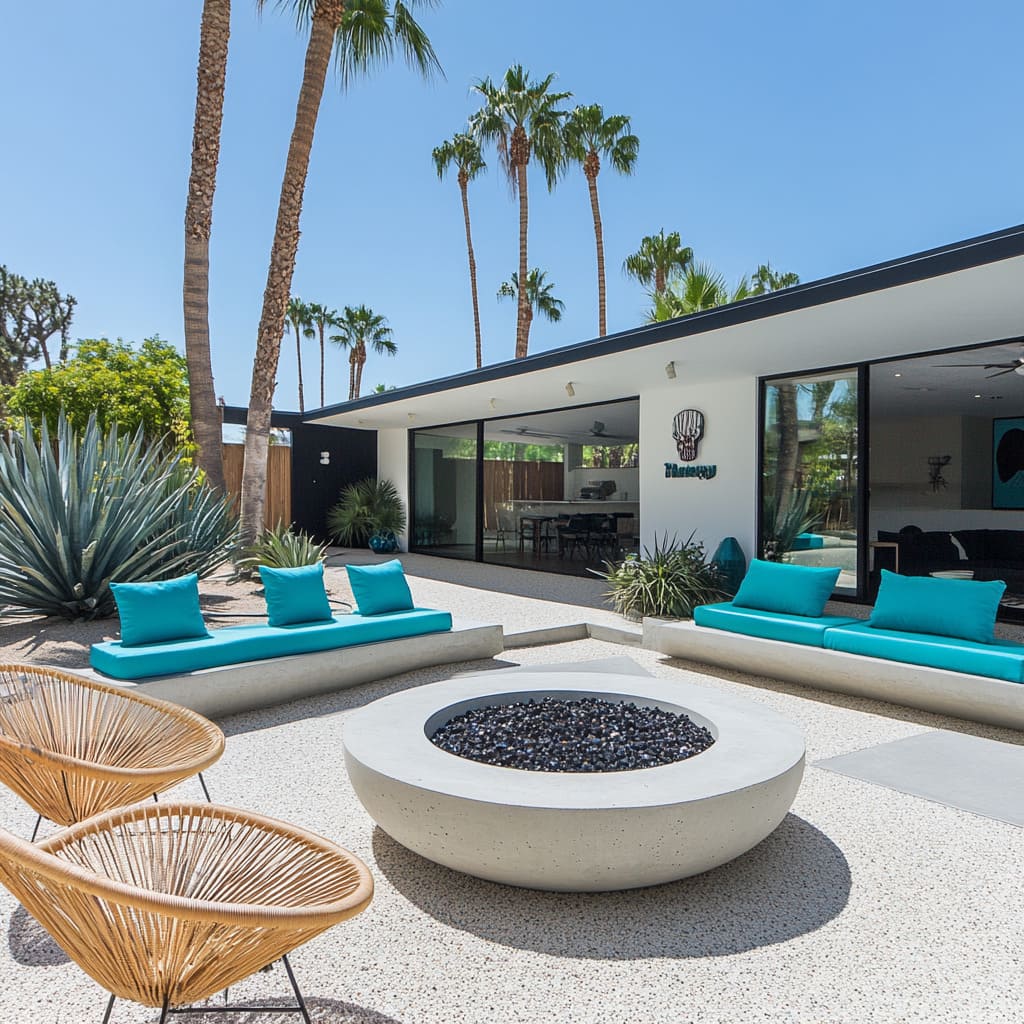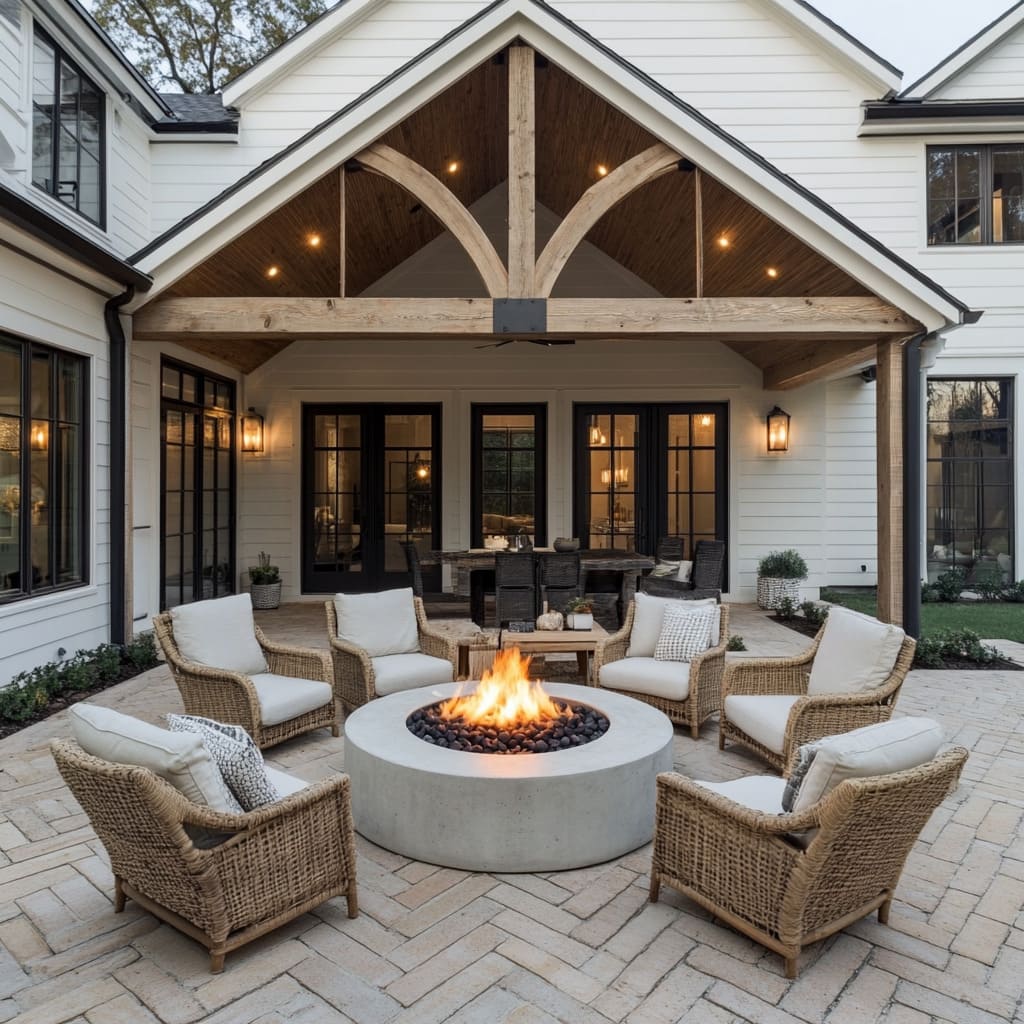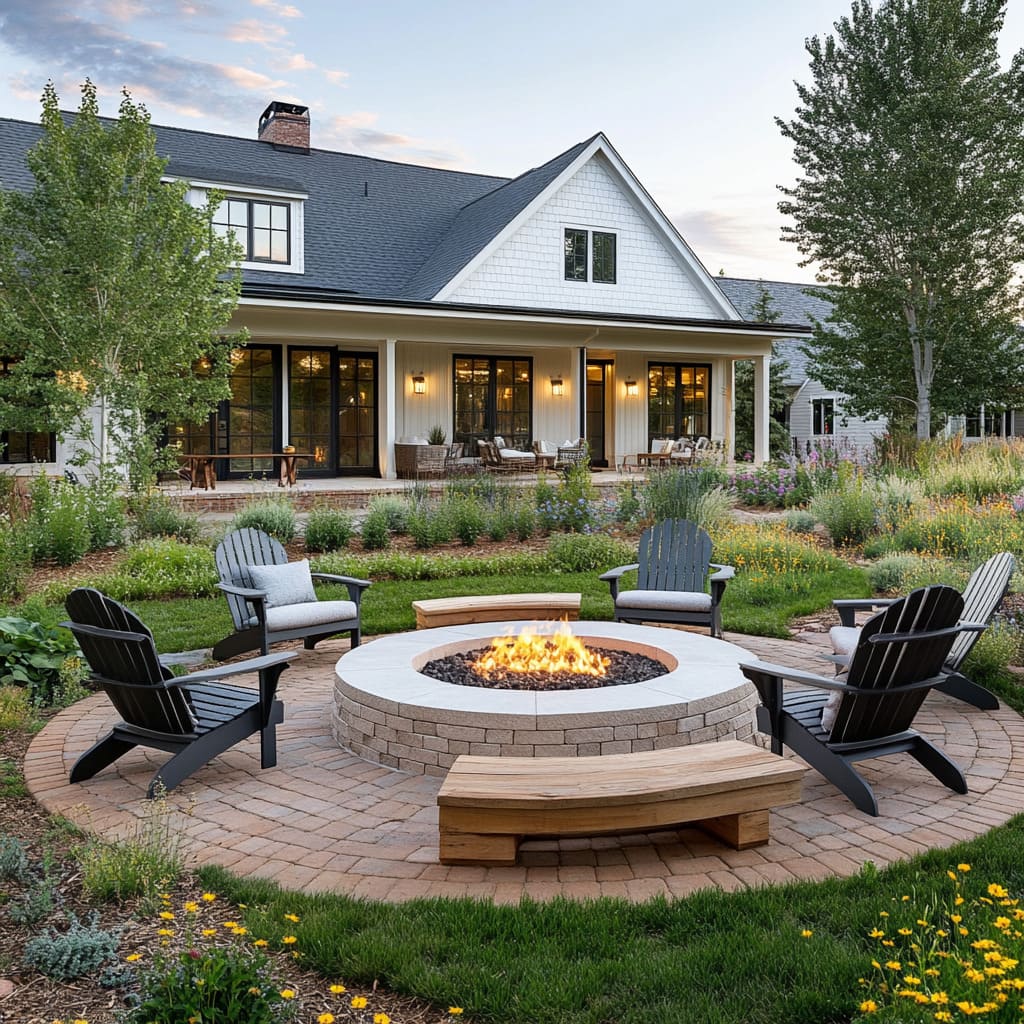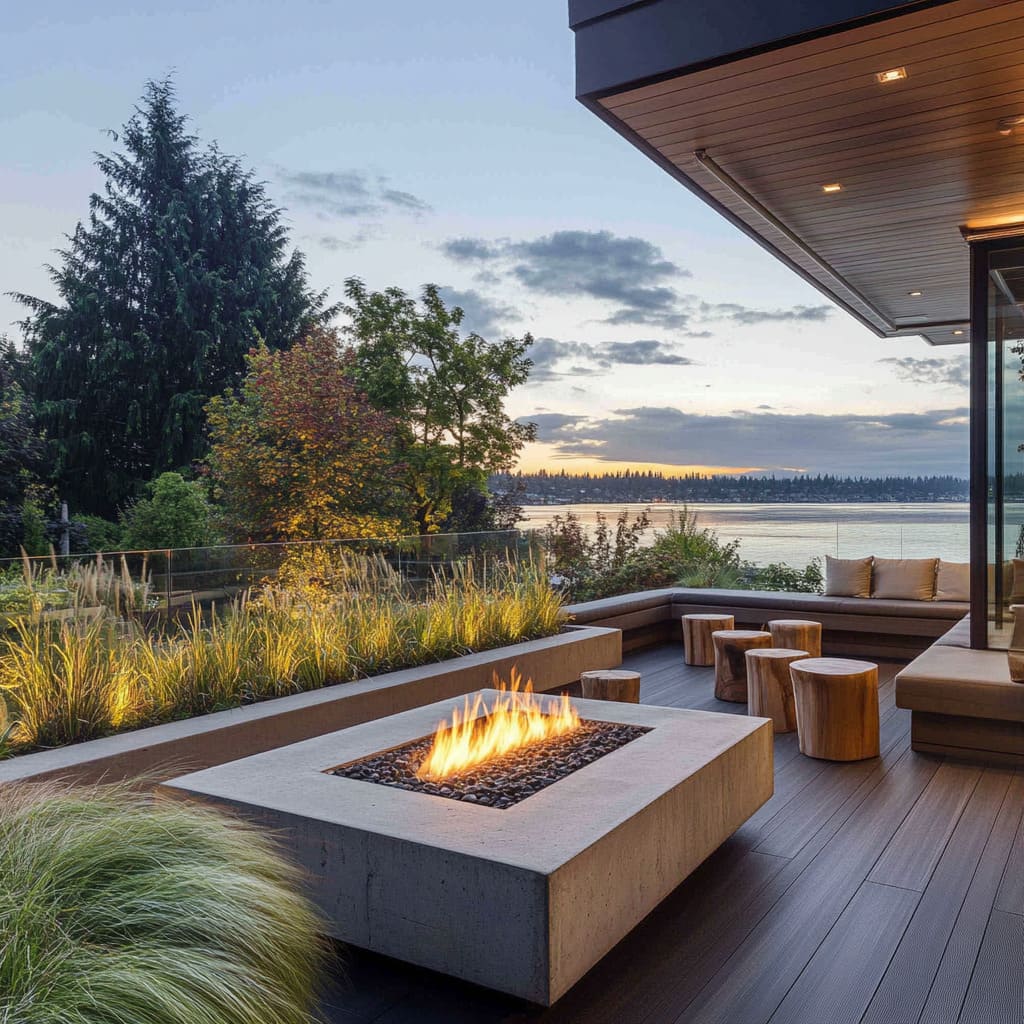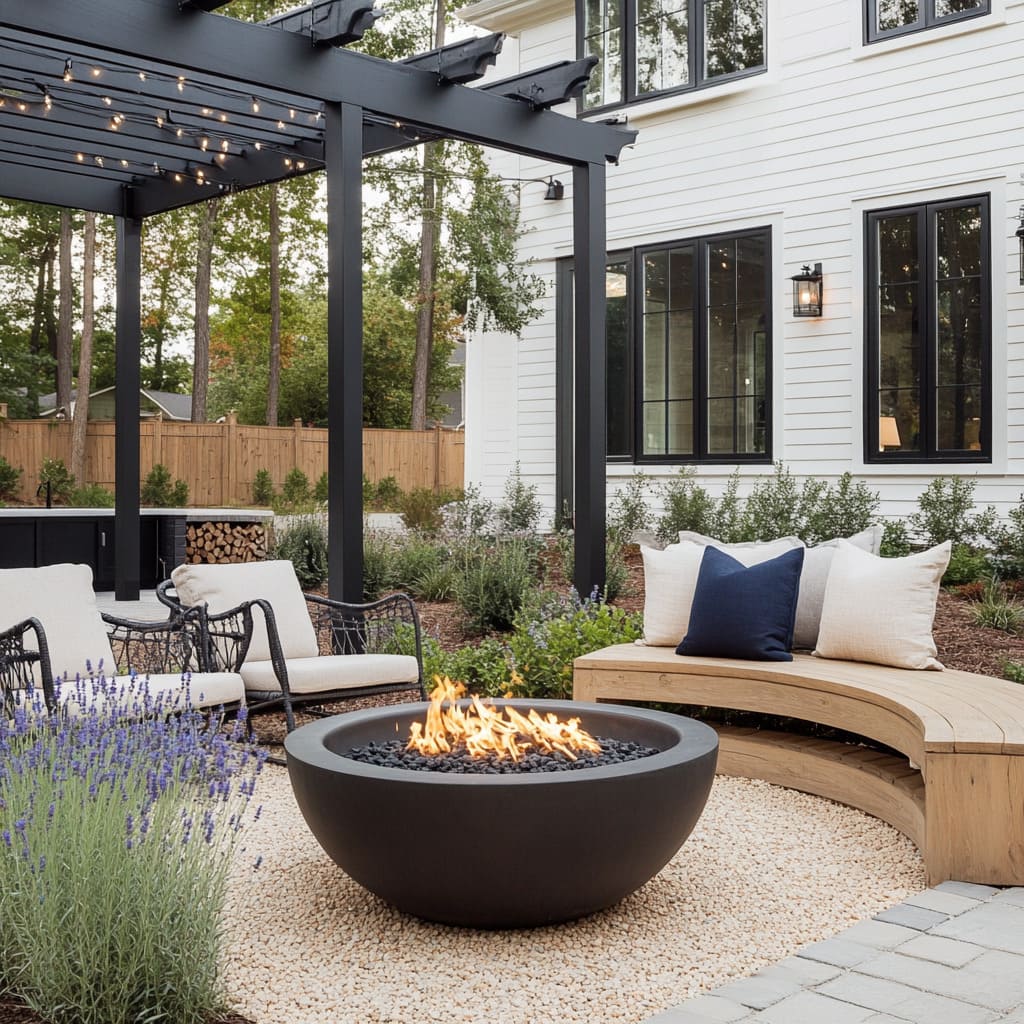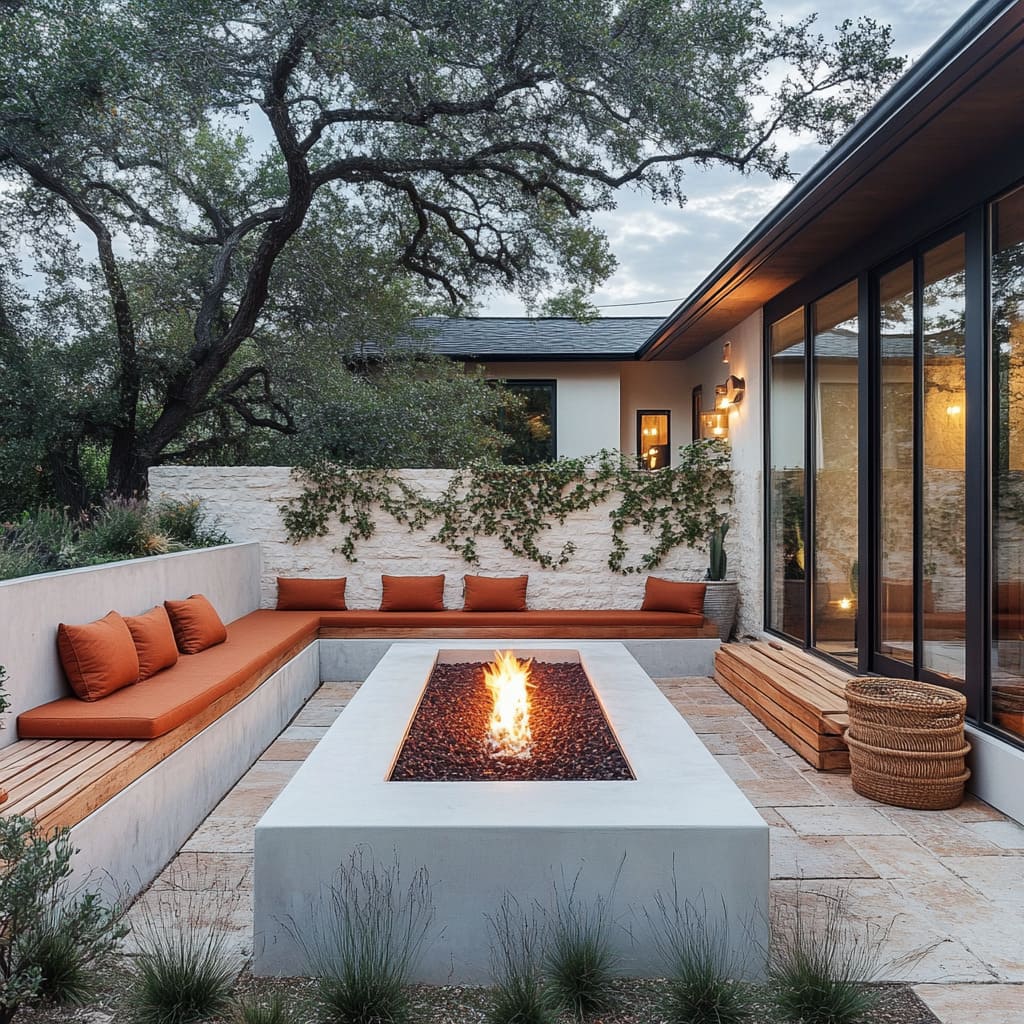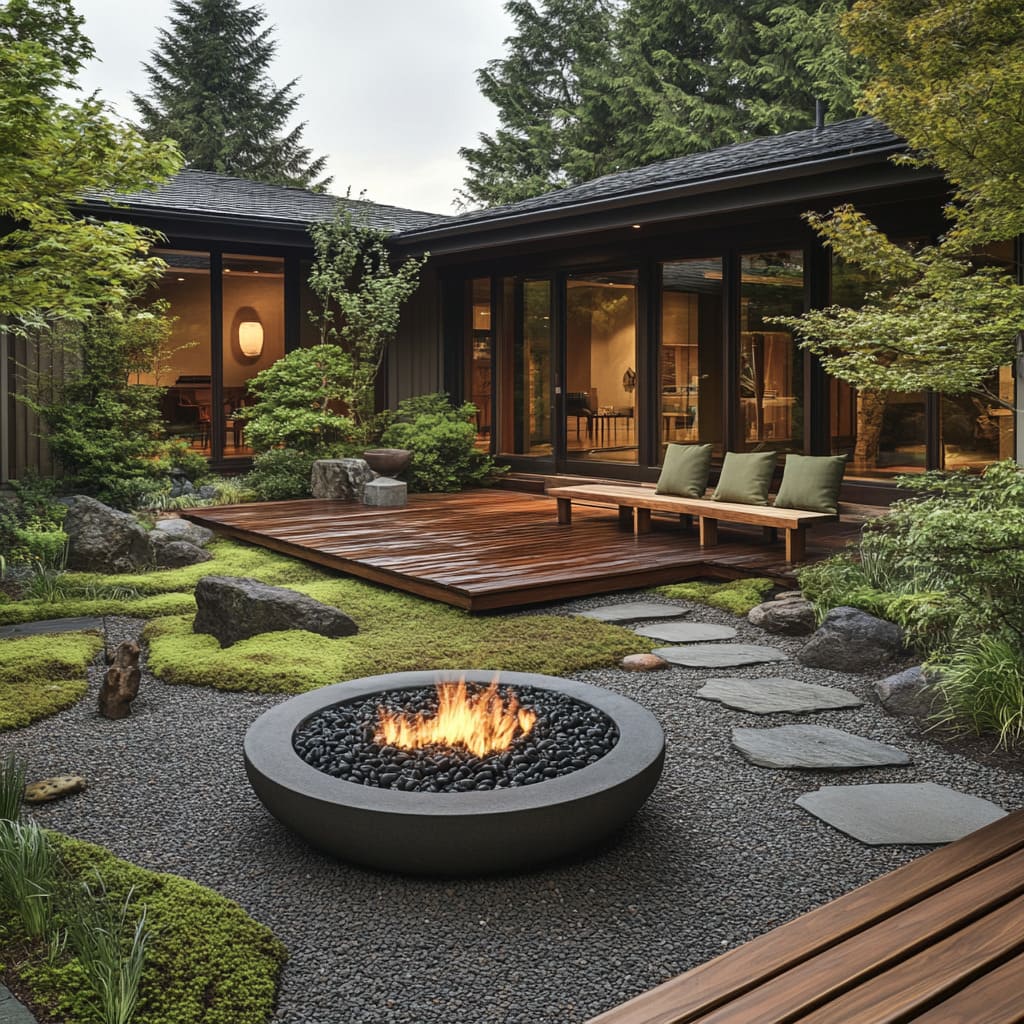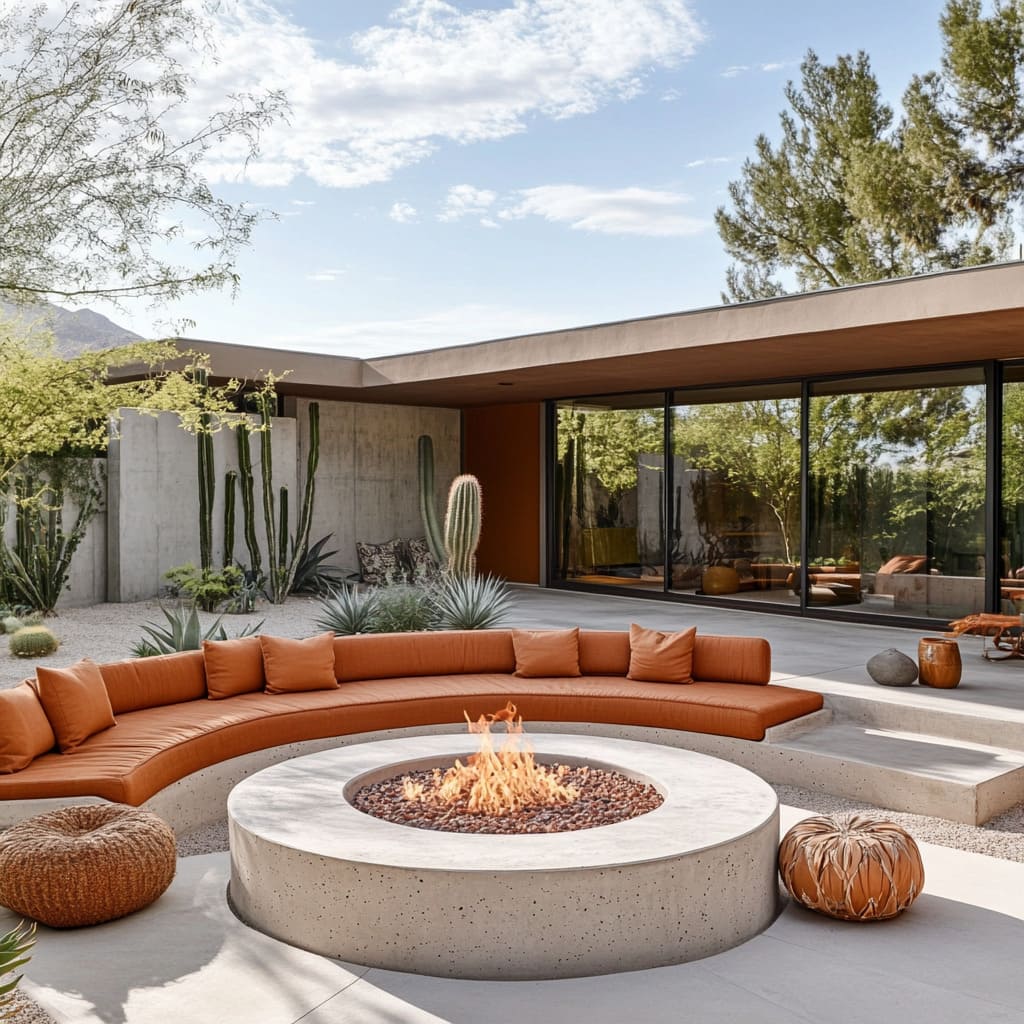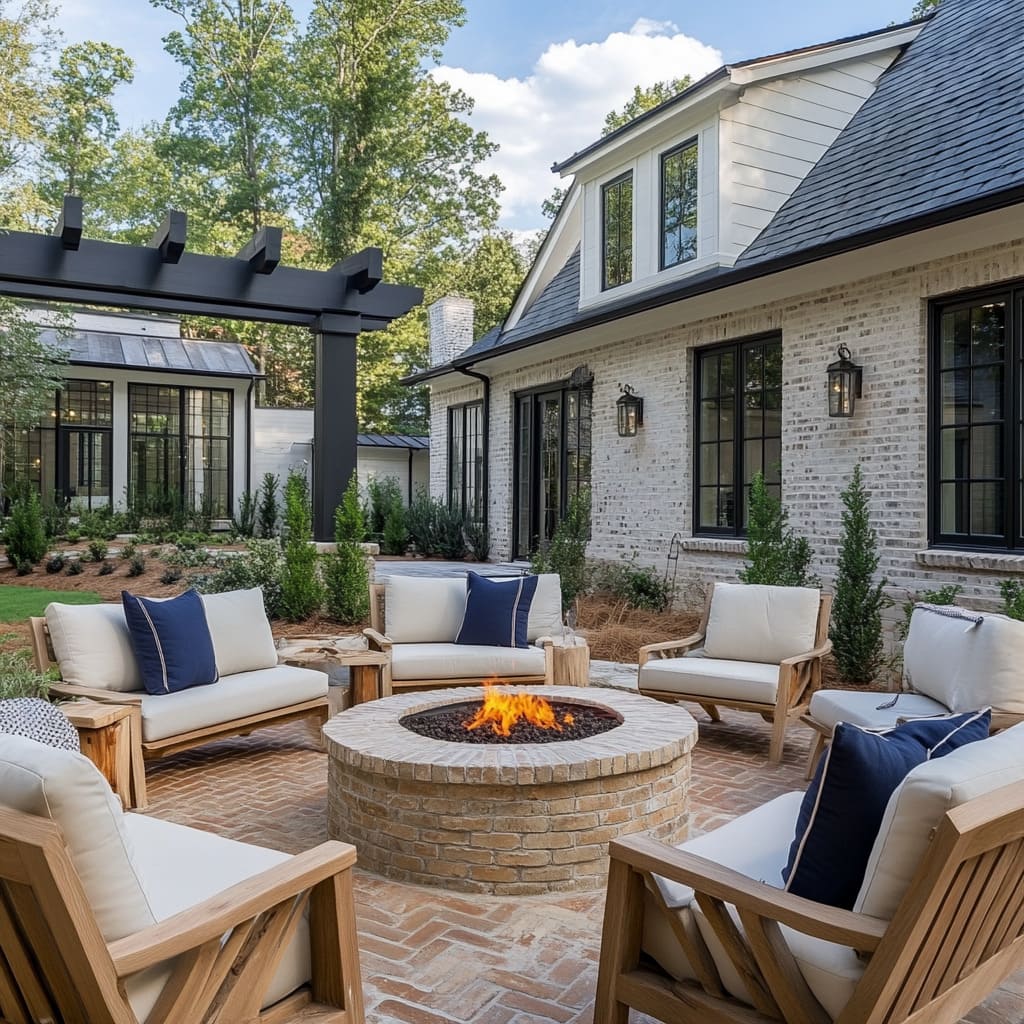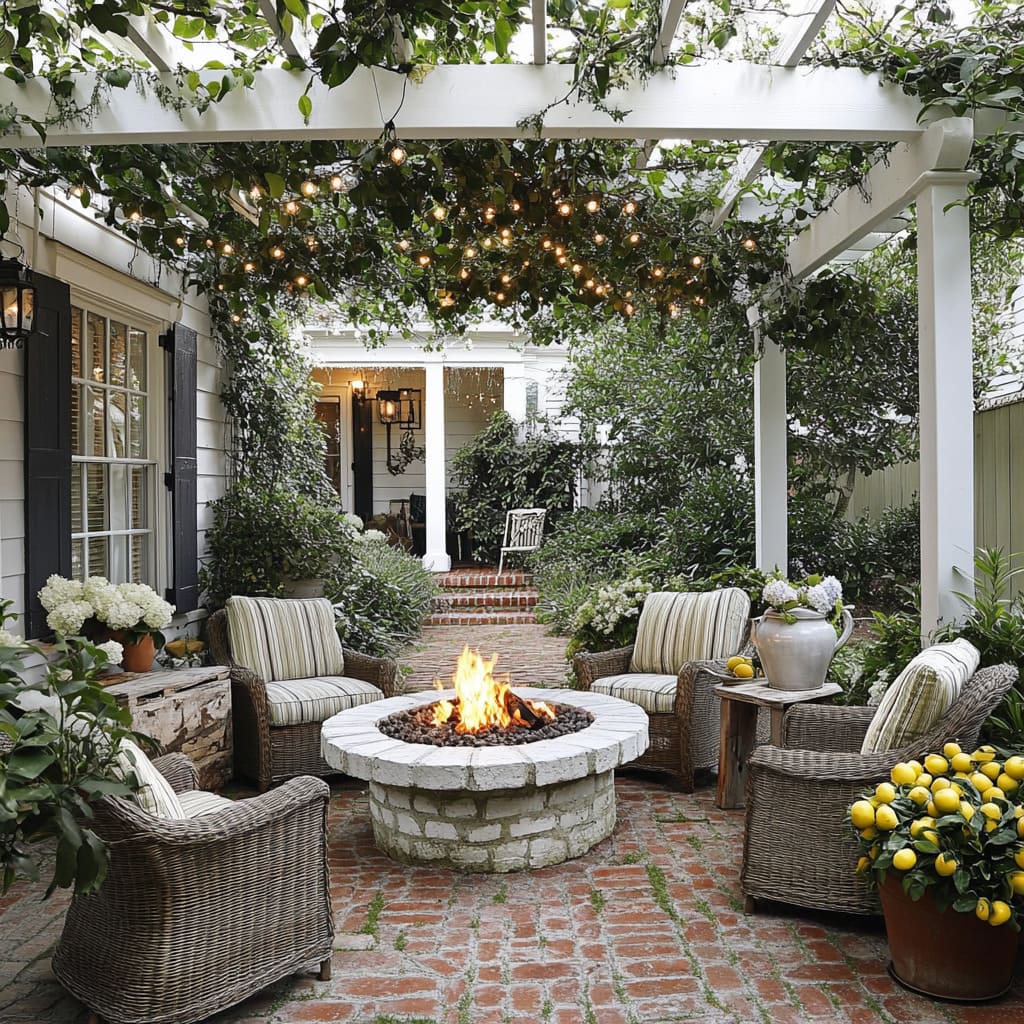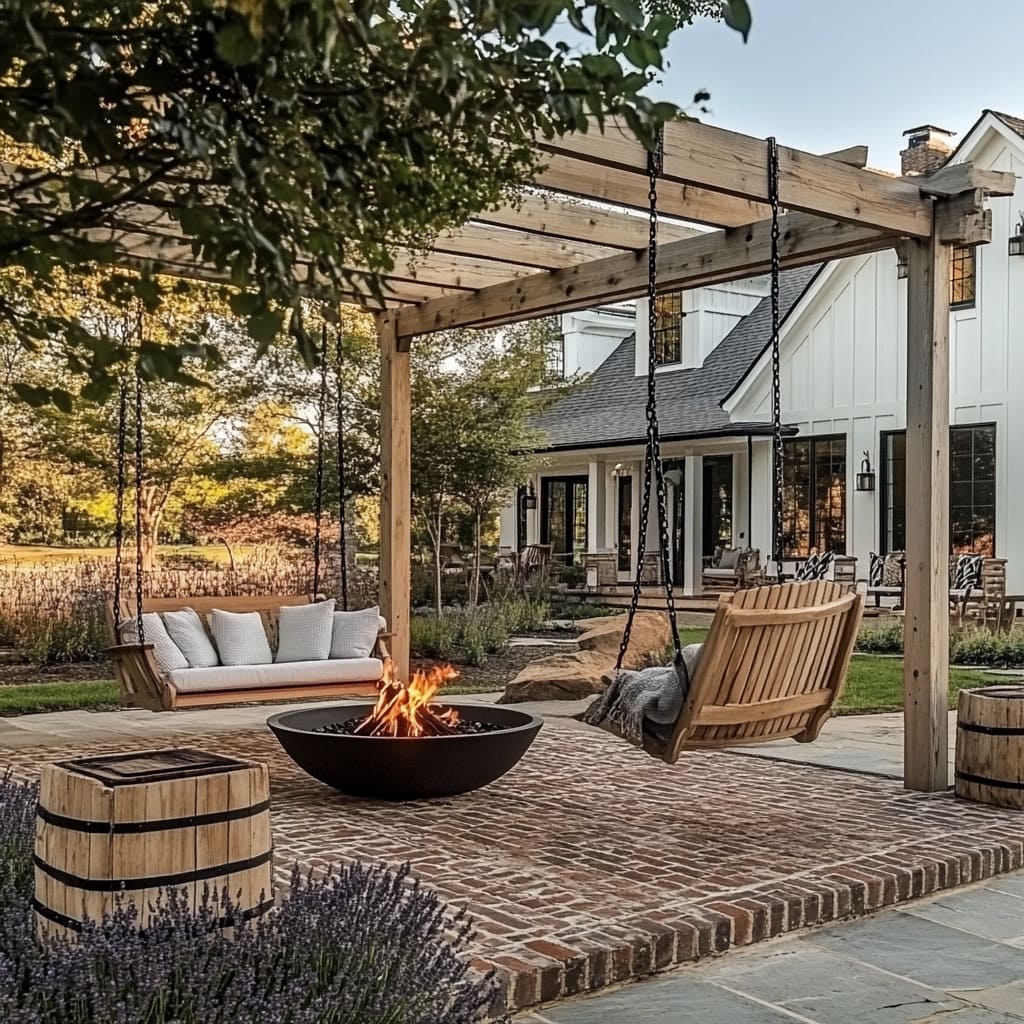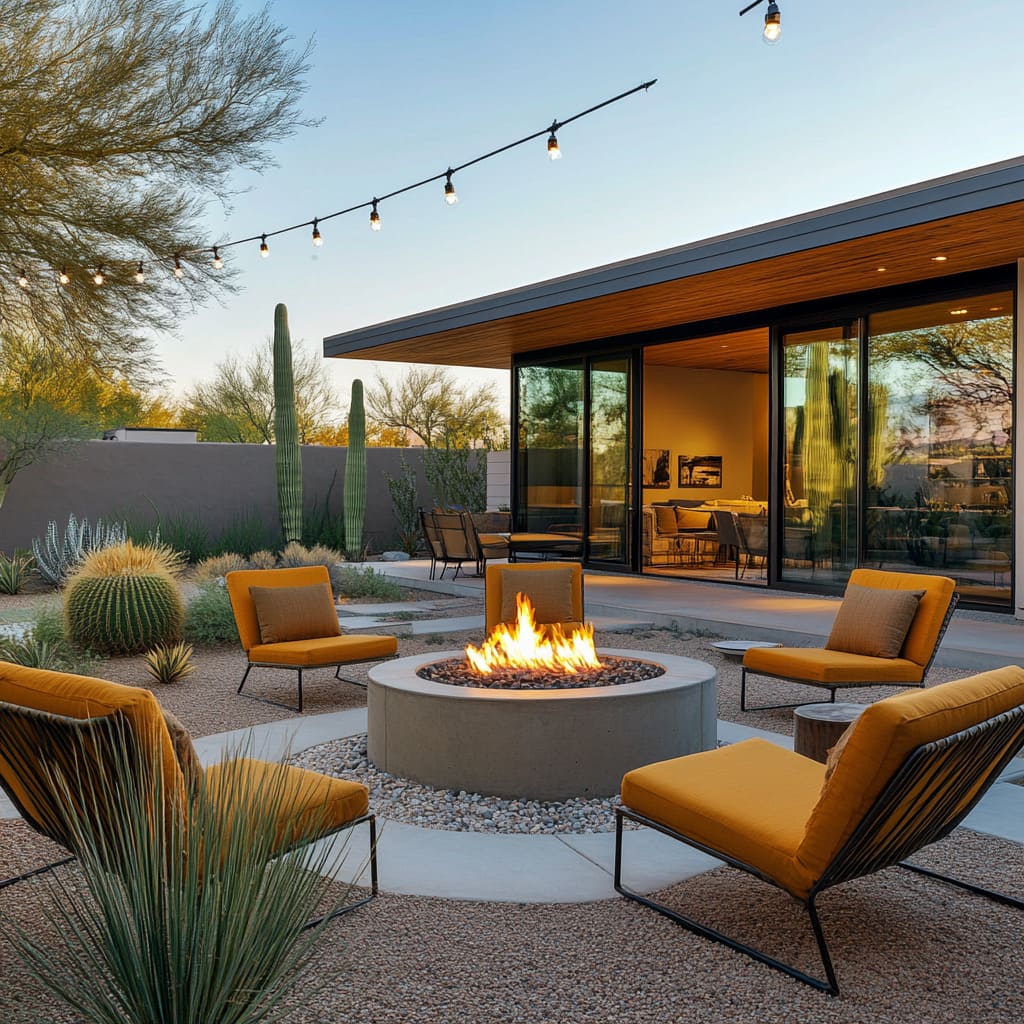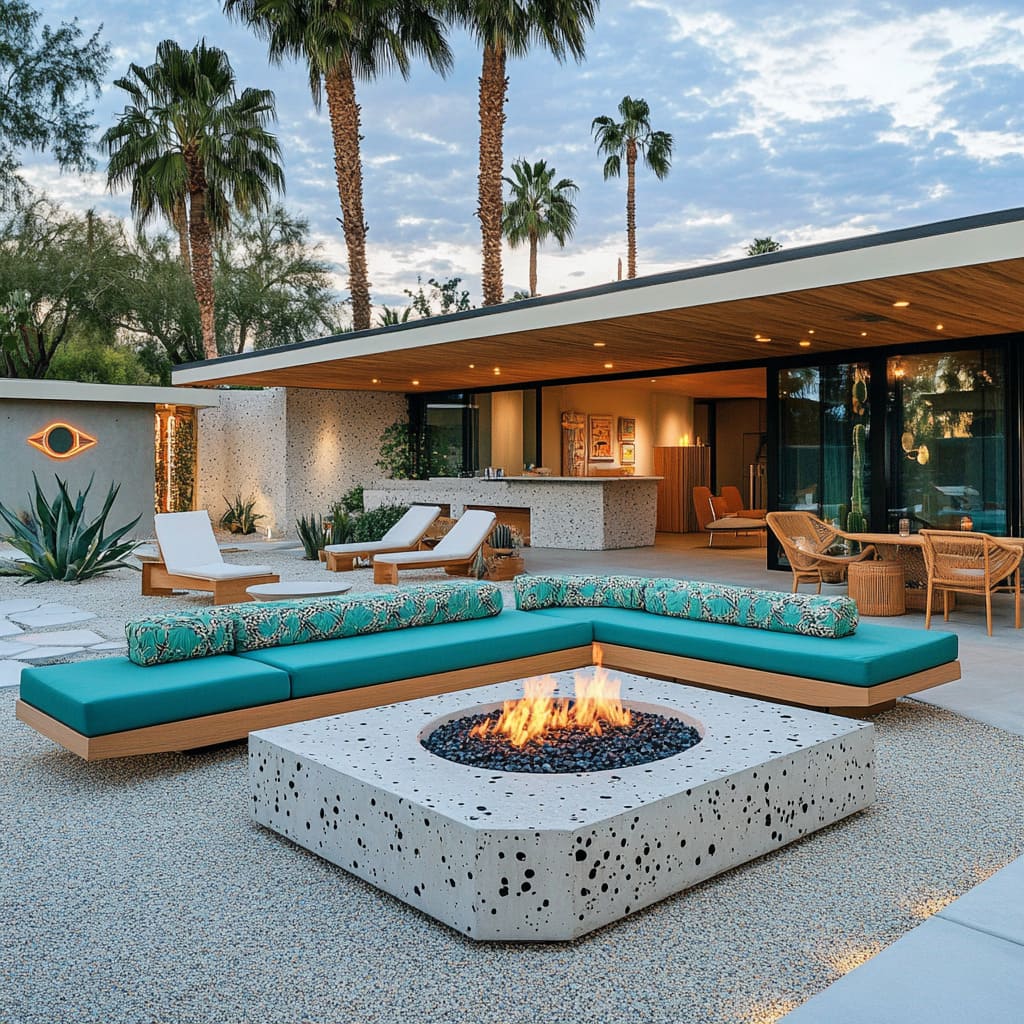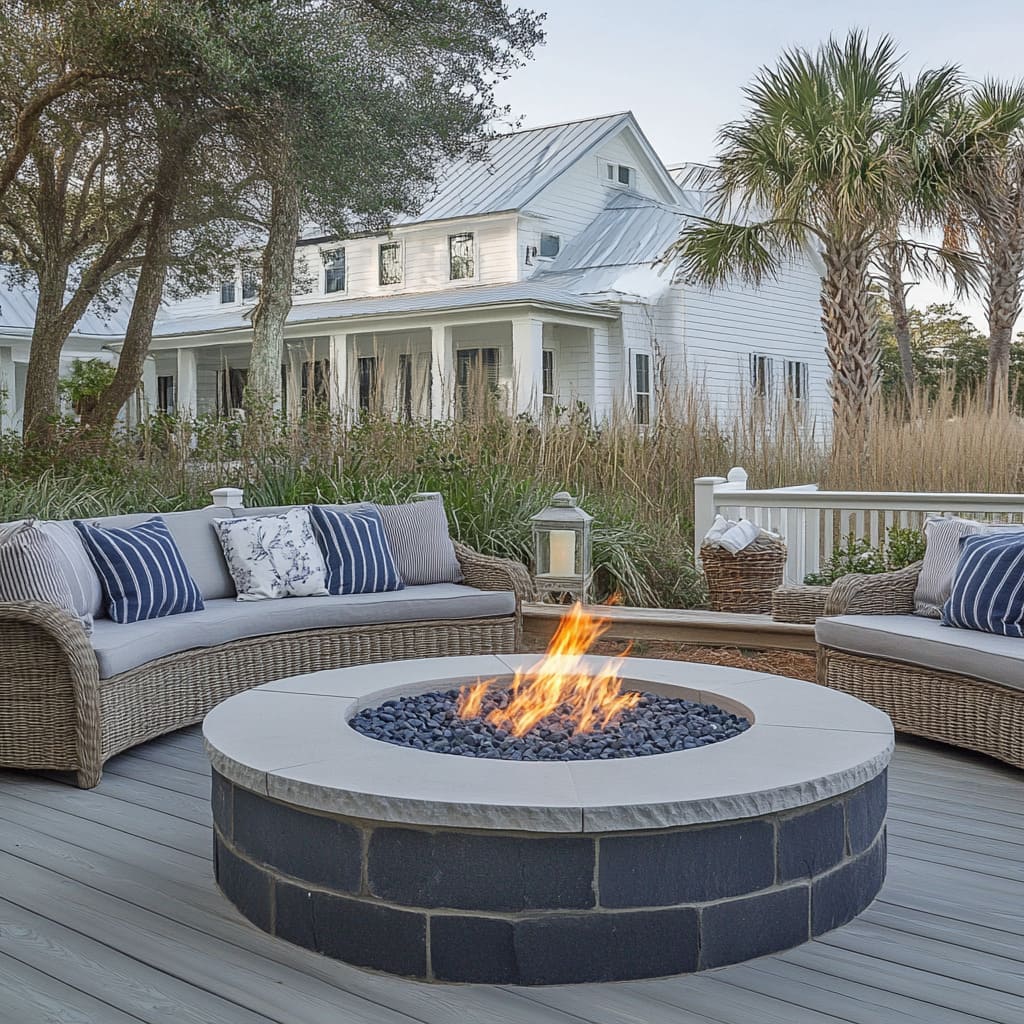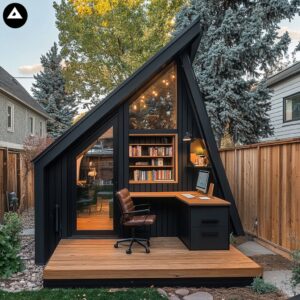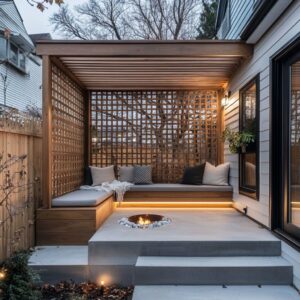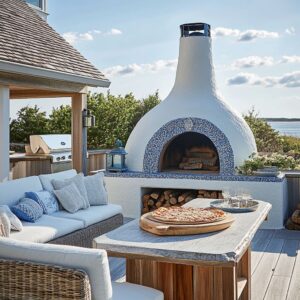A firepit isn’t just a backyard feature—it’s a gathering spot, a place where warmth, conversation, and design come together. Whether it’s a sleek, modern setup with concrete and steel or a rustic nook surrounded by aged brick, the right design choices can turn a simple firepit into the focal point of an outdoor space.
The best firepit area ideas go beyond the fire itself. They consider seating arrangements that invite relaxation, layered materials that add depth, and overhead structures that frame the space.
Lighting, textures, and even plant selections all play a role in shaping an area that feels intentional and connected to its surroundings. From cozy farmhouse patios to desert-inspired lounges, the details make all the difference.
This guide breaks down the smartest design strategies—subtle elevation changes, mixed seating styles, climate-conscious materials, and more—so you can create a firepit space that’s not only beautiful but functional year-round.
The Power of Integrated Levels and Transitions
A well-designed firepit area isn’t just about the fire itself—it’s about how the space flows. One of the smartest ways to shape that flow is by using varying levels to create a sense of separation without closing things off.
A split-level deck or a raised platform around a firepit can naturally define the seating area, making it feel intentional while keeping the yard open and inviting. Think about some of the best backyard firepit ideas—many use subtle elevation changes to mark the firepit zone without the need for walls or fencing.
A slightly elevated wood deck, for example, creates a natural border that signals a shift in function, turning a simple patio into a structured outdoor lounge. The beauty of this approach is that it doesn’t just look good—it adds functionality.
Built-in seating along the edges of an elevated deck can double as hidden storage for firewood or outdoor cushions, keeping everything within reach while maintaining a clean aesthetic.
If your yard has an existing slope or uneven terrain, use that to your advantage. Instead of leveling everything out, work with the natural contours by creating a sunken firepit lounge or a raised terrace that steps down from the main deck.
These subtle variations make an outdoor space feel layered and dynamic, encouraging movement and offering different vantage points to enjoy the warmth of the fire.
For a seamless design, choose materials that visually connect different levels. A wooden deck that transitions into a stone or gravel firepit area feels cohesive while adding a tactile contrast underfoot.
The goal is to make the space feel like an extension of the home rather than an afterthought—whether it’s a modern farmhouse setting with warm wood tones or a sleek contemporary space with concrete and steel elements. A well-planned transition isn’t just about aesthetics—it changes how people interact with the space.
A raised firepit deck invites guests to linger, while a sunken lounge with built-in seating creates a cozy retreat. Whether you’re designing from scratch or upgrading an existing layout, working with levels can give your firepit area a natural sense of structure without making it feel confined.
Seating That Fosters Both Conversation and Flexibility
A great firepit setup isn’t just about warmth—it’s about how people gather around it. The best designs consider different ways people like to sit, whether they prefer sinking into a cushioned bench, leaning back in a sturdy chair, or casually perching on a stool.
Mixing built-in and movable seating makes an outdoor space adaptable, letting it shift from a cozy fireside chat to a lively gathering with ease. Some of the most well-thought-out outdoor firepit seating ideas pair permanent benches with freestanding chairs, ottomans, or swings.
This layered approach keeps the space functional and inviting. Built-in benches give a space structure and maximize seating without cluttering the layout, while movable chairs add flexibility.
A partial wraparound bench defines the firepit zone while leaving one side open for extra chairs when more guests arrive. This keeps the space intimate without feeling closed off.
For even more comfort, consider variations in height and depth. A deep-seated bench with thick cushions offers a laid-back option, while lightweight stools or side tables give people the freedom to move around as needed.
Thoughtful positioning also matters—a curved seating arrangement naturally pulls people into conversation, while a mix of low and high-backed seating ensures everyone finds their preferred spot. The goal is to create a seating arrangement that adapts effortlessly, whether you’re unwinding solo by the fire or hosting a full house.
By combining different types of seating, you’ll make the space feel relaxed and welcoming for any occasion.
Mixed Seating Heights and Surfaces
A well-designed firepit sitting area isn’t just about the number of seats—it’s about making sure everyone finds a comfortable spot. Mixing different seating heights and materials helps create a space that feels natural and inviting, whether someone wants to lounge, sit upright, or simply rest for a moment.
One of the smartest ways to achieve this is by combining high-back chairs with lower ottomans or built-in benches. The variation isn’t just for looks—it caters to different needs.
Kids and more relaxed guests might prefer the ease of a lower seat, while taller individuals or those with mobility concerns often appreciate the support of a higher-backed chair. A curved or wraparound bench can provide a structured look, while standalone stools and poufs offer flexibility, allowing people to move seats closer to the fire or reposition them as needed.
If you want the space to feel both functional and stylish, balance comfort with practicality. Low-profile seating may look great, but if it’s too deep or difficult to get up from, it might not be the best choice for everyone.
Instead, aim for a mix—some structured seating for stability and some casual options for flexibility. Another key element is surface space.
A small coffee table or a few side tables at arm’s reach can make a big difference, giving guests a place to set down drinks or snacks without having to juggle everything in their lap. Whether the setting leans rustic with natural wood finishes or modern with sleek metal and stone, having varied seating heights and practical surfaces ensures that the firepit area remains comfortable and inviting for all.
Subtle Use of Pergolas and Overhead Structures
A backyard firepit is more than just a seating area—it’s an extension of your home’s outdoor living space. While a fire naturally draws people in, a well-placed pergola or overhead structure gives the entire setting a sense of definition.
Instead of feeling like an open patch in the yard, a firepit under a pergola feels intentional, creating a cozy, framed gathering spot that blends seamlessly with the rest of the home.
A thoughtfully designed backyard firepit area doesn’t rely solely on walls or fencing to create a sense of enclosure. Overhead beams, roof extensions, or a pergola can mark the space while keeping it visually open.
They also offer a natural spot for string lights, pendant lamps, or even a hanging chair, adding both function and ambiance. The structure itself can soften harsh sunlight during the day while allowing for a warm, inviting glow at night.
For an extra layer of character, vines or climbing plants can weave through the beams over time, bringing a relaxed, organic feel to the space. If your home has specific architectural details—like black window frames or warm wood trim—staining or painting your pergola to match creates a seamless connection between indoor and outdoor areas.
If you’re considering a pergola for your firepit setup, think beyond simple shade. Could it support a swinging bench for added seating?
Could sheer curtains be draped for extra privacy? A little planning can transform an overhead structure into more than just an accent—it becomes a defining part of the space, balancing openness with just the right amount of enclosure.
Climate-Responsive Choices
A firepit area should be built to last, and that means choosing materials that stand up to the local climate. The right combination of surfaces, seating, and ground cover can make a huge difference in durability, maintenance, and year-round comfort.
A firepit in a dry, sun-soaked setting needs different materials than one in a humid, rainy region, and overlooking these factors can lead to issues like excessive heat buildup, water damage, or high maintenance costs.
In desert environments, heat-reflecting materials like stucco, smooth concrete, or light-colored stone help prevent surfaces from becoming too hot under direct sunlight. Gravel or crushed stone is often used instead of grass, since it allows rain to drain easily without pooling.
This is why many modern desert firepit designs rely on textured concrete seating, heat-resistant stone flooring, and minimal softscape elements for a clean, functional setup.
On the other hand, humid or rainy climates require a different approach. Wooden decks, built-in benches, and surrounding walkways should be made from pressure-treated wood, composite materials, or weather-sealed stone to prevent rot and warping.
Drainage is key—without it, standing water can cause materials to break down faster. Many firepit areas in forested or coastal settings use pebble borders or slightly raised platforms to keep moisture from accumulating.
Landscaping around firepit areas also plays a critical role in managing climate-related challenges. In dry climates, drought-tolerant plants like agave, cacti, or ornamental grasses keep the space visually interesting without requiring much water.
In wetter areas, well-placed ground cover and native plants can help absorb excess moisture while adding greenery. The goal is to create a space that holds up over time and remains comfortable no matter the season.
Paying attention to climate when selecting materials will keep your firepit area looking great and functioning properly for years to come.
Establishing Visual Continuity with Home Architecture
A firepit area should feel like an extension of the home, not an isolated feature. The most well-designed outdoor spaces borrow details from the house itself, creating a smooth transition between indoor and outdoor living.
Whether it’s repeating a material from the facade, using complementary colors, or mirroring architectural shapes, these subtle design choices make a firepit area feel intentional rather than an afterthought. One of the easiest ways to create this connection is by incorporating materials that already exist in the home’s exterior.
If the house has a brick or stone foundation, using the same material for the firepit cap or seating base instantly ties the two together. A pergola or overhead beam that echoes the roofline reinforces this link even further, subtly drawing the eye from one space to the next.
Black-framed windows? Try a black pergola or metal firepit bowl to carry that detail outdoors.
White trim? Consider white-painted brick or concrete for a seamless look.
These small details have a big impact. Without them, an outdoor firepit can feel disconnected, like a standalone feature rather than part of the home’s natural flow.
But when the right materials and design elements are echoed, everything clicks into place. If you’re looking for ideas for a firepit area that feels cohesive, start by taking cues from your home’s existing style.
Whether the goal is a rustic farmhouse feel with reclaimed wood accents or a sleek modern aesthetic with smooth concrete and steel, letting the house guide the choices will ensure the space feels balanced and well-integrated.
Approaches to Year-Round Use
A firepit is meant to be enjoyed beyond just summer evenings, but without the right setup, colder months or unexpected rain can quickly cut those gatherings short. Thoughtfully designed firepit areas make it possible to use the space comfortably in any season, whether it’s by adding overhead coverage, selecting weather-resistant materials, or incorporating features that offer warmth and shelter.
In areas with frequent rain or snow, having a plan to protect both the firepit and the seating makes a huge difference. A pergola with a retractable cover, a simple overhang, or even a well-placed wall can shield the area from wind and precipitation while keeping the fire accessible.
Weatherproof cushions and furniture materials—such as teak, powder-coated metal, or sealed stone—help prevent wear and tear from moisture, so the space stays looking great all year long.
For milder climates, a lightweight structure like a pergola or an awning can make the space more usable during drizzles or chilly evenings. Features like built-in swings with cozy cushions, a partial roof extension, or an outdoor heater can help extend the season for firepit gatherings without major renovations.
Another detail that often goes overlooked is drainage. If the area is built on gravel or a raised platform, rainwater won’t collect, keeping the space usable even after a storm.
For snow-prone locations, storing a fitted firepit cover nearby can help protect the surface and make it easier to relight when the weather clears. Designing with year-round use in mind means fewer interruptions and more evenings spent enjoying the fire, no matter what the forecast says.
A little planning can turn a seasonal feature into a permanent outdoor retreat.
Embracing Subtle Aromas and Sensory Layers
A firepit does more than add warmth—it creates an atmosphere. While the flickering flames set the mood, the surrounding scents can elevate the experience in a way that’s often overlooked.
The right selection of plants around a firepit can turn a simple outdoor gathering into something far more inviting, engaging the senses beyond just sight and sound. Aromatic herbs like rosemary, lavender, and thyme aren’t just visually appealing—they subtly release their fragrance when warmed by the fire’s heat.
Placing these plants strategically around the firepit lets their scent drift naturally into the seating area, enhancing the feeling of relaxation. On cooler nights, a gentle breeze can carry notes of fresh herbs through the air, creating an effect that feels effortless yet intentional.
The trick to making this work is spacing. Plants should be close enough to let their fragrance be enjoyed but not so near that they risk damage from the fire’s heat or stray embers.
Raised beds or decorative planters along the perimeter work well, allowing you to control placement while adding structure to the layout. A mix of taller ornamental grasses and low-growing herbs can create a layered, natural feel without overwhelming the space.
For a more immersive experience, consider mixing textures as well. Soft, feathery plants like ornamental grasses can contrast with the sturdier structure of rosemary or sage, giving both visual and tactile variety.
And if the goal is to create a relaxing retreat, plants with calming properties—like lavender—can subtly influence the atmosphere, making the firepit area feel even more welcoming. This approach isn’t about overloading the space with greenery but rather about choosing elements that enhance the experience in an understated way.
A well-planned firepit area should appeal to all the senses, creating an environment that feels comfortable, natural, and effortlessly inviting.
Conclusion
A firepit area is more than a simple outdoor feature—it’s a space where design, function, and atmosphere come together. Looking at well-planned examples, certain patterns stand out: seating that encourages conversation, thoughtful layering of materials, overhead structures that add depth, and landscaping that blends beauty with practicality.
Each element plays a role in shaping a space that feels natural and inviting. The best firepit designs aren’t just visually appealing; they feel effortless and comfortable.
Ground materials, whether stone, gravel, or decking, influence both aesthetics and maintenance. Overhead structures frame the space and add warmth, while lighting choices dictate whether the atmosphere leans toward cozy or modern.
Even plant selection can subtly enhance the experience, creating a sensory layer that changes with the seasons.
When designing your own firepit area, consider how each decision ties back to your home’s architecture and surrounding landscape. A well-integrated space should feel like a seamless extension of your outdoor living area, adaptable to different weather conditions and welcoming in any season.
With careful planning, the result is a firepit setting that invites people in, encourages lingering conversations, and becomes a natural gathering spot for years to come.

